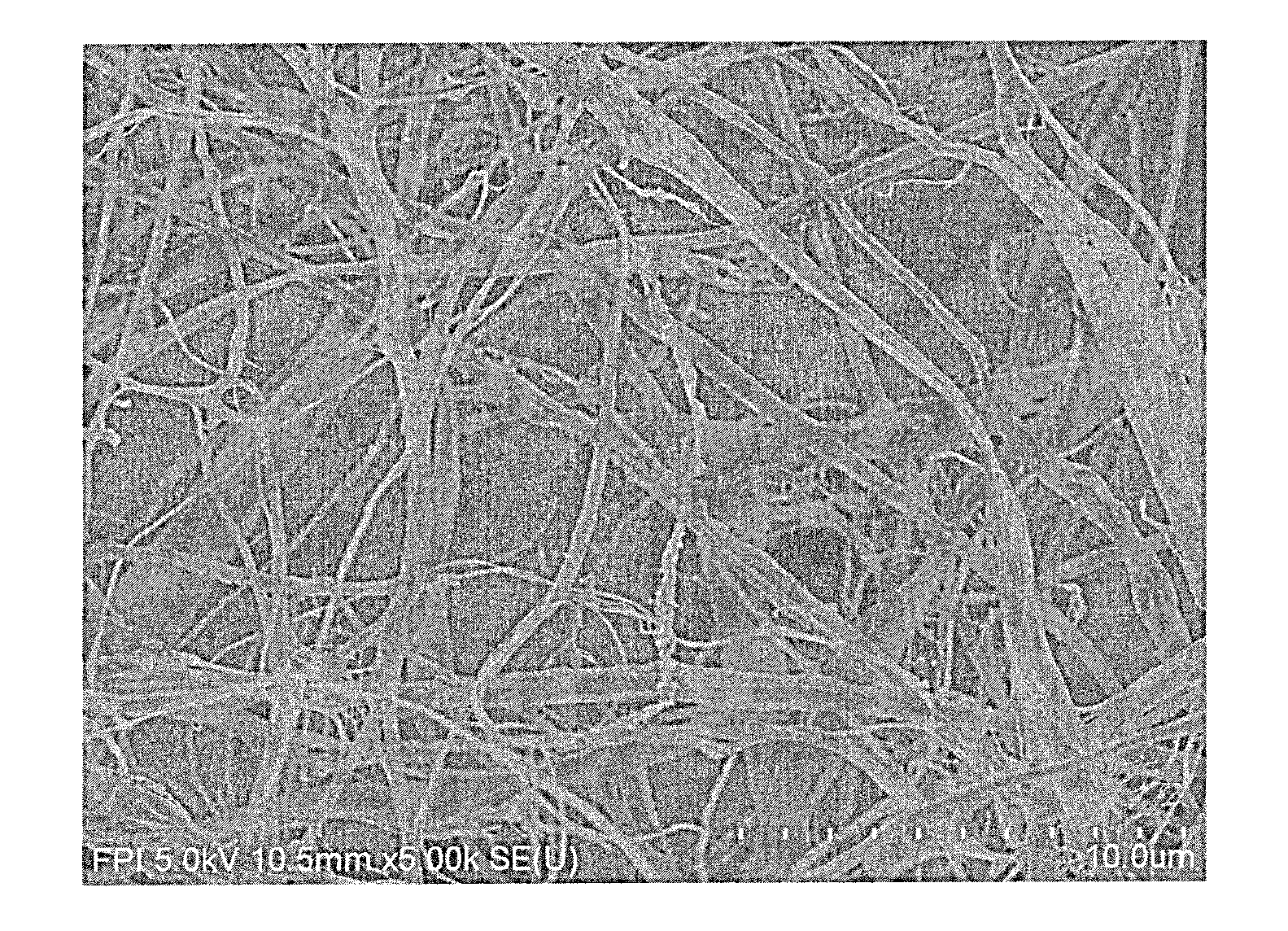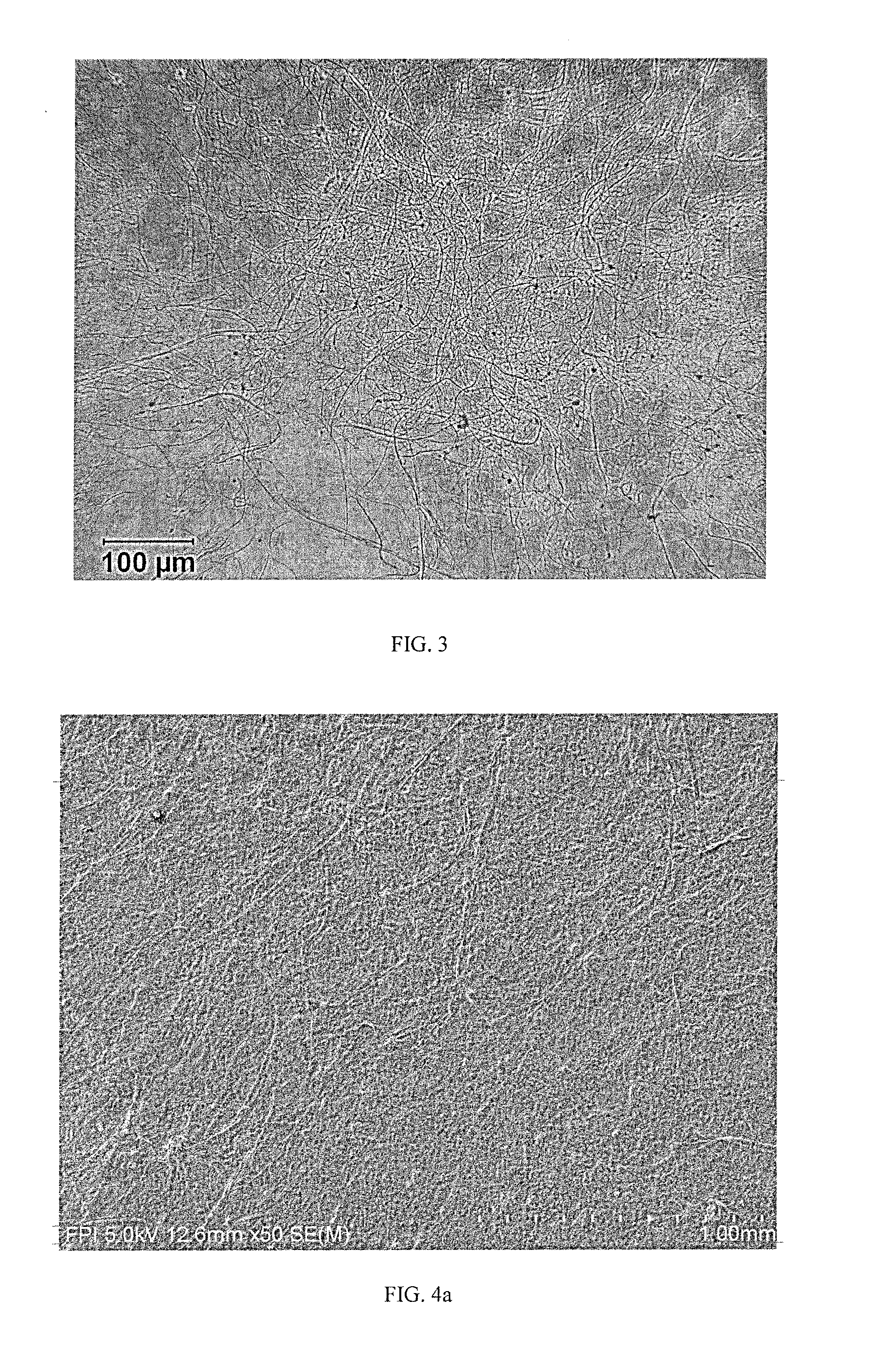High aspect ratio cellulose nanofilaments and method for their production
a cellulose nanofilament, high-aspect ratio technology, applied in papermaking, manufacturing tools, transportation and packaging, etc., can solve the problems of low re-enforcement power of common wood fibers including softwood fibers, and low re-enforcement power of long wood fibers or plant fibers in paper webs, etc., to achieve high consistency, high consistency, and high consistency.
- Summary
- Abstract
- Description
- Claims
- Application Information
AI Technical Summary
Benefits of technology
Problems solved by technology
Method used
Image
Examples
example 1
[0055]CNF was produced from a bleached softwood kraft pulp using a 36″ double disc refiner with a standard Bauer disc pattern 36104 and running at 900 RPM and 30% consistency. FIG. 2 shows Scanning Electron Microscopy (SEM) image of CNF made in this way after 8 passes. FIG. 3 is the corresponding micrograph using light microscopy. The high aspect ratio of the material is clearly visible.
example 2
[0056]The CNF produced from bleached softwood kraft pulp of Example 1 was dispersed in water to 2% consistency in a laboratory standard British disintegrator (TAPPI T205 sp-02). The dispersed suspension was used to make cast films of 100 μm thickness. The air dried sheet was semi transparent and rigid with a specific density of 0.98 g / cm3 and an air permeability of zero (as measured by a standard PPS porosity meter). FIG. 4a and FIG. 4b show SEM micrographs of the CNF film at two magnification levels. The CNF formed a film-like, well bonded microstructure of entangled filaments.
[0057]FIG. 4c presents the load-strain curve as measured on an Instron Testing Equipment at a crosshead speed of 10 cm / min using a strip with dimensions of 10 cm length×15 mm width×0.1 mm thickness. The tensile strength and stretch at the break point were 168 N and 14%, respectively.
example 3
[0058]FIG. 5a and FIG. 5b compare the properties of 60 g / m2 handsheets made from reslushed dry lap bleached hardwood kraft pulp (BHKP) blended with varying levels of a mill refined bleached softwood kraft pulp (BSKP) or CNF produced according to this invention using the same procedure described in Example 1. Refined BSKP with a Canadian standard freeness CSF of 400 mL was received from a mill producing copy and offset fine paper grades. All sheets were made with addition of 0.02% cationic polyacrylamide as retention aid. The results clearly show that on increasing the dosage of CNF the tensile strength (a) is dramatically increased and the PPS porosity (b) is drastically reduced. A low PPS porosity value corresponds to very low air permeability. On comparing CNF with mill refined BSKP, the CNF-reinforced sheet was 3 times stronger than that reinforced by BSKP.
PUM
| Property | Measurement | Unit |
|---|---|---|
| Percent by mass | aaaaa | aaaaa |
| Length | aaaaa | aaaaa |
| Width | aaaaa | aaaaa |
Abstract
Description
Claims
Application Information
 Login to View More
Login to View More - R&D
- Intellectual Property
- Life Sciences
- Materials
- Tech Scout
- Unparalleled Data Quality
- Higher Quality Content
- 60% Fewer Hallucinations
Browse by: Latest US Patents, China's latest patents, Technical Efficacy Thesaurus, Application Domain, Technology Topic, Popular Technical Reports.
© 2025 PatSnap. All rights reserved.Legal|Privacy policy|Modern Slavery Act Transparency Statement|Sitemap|About US| Contact US: help@patsnap.com



